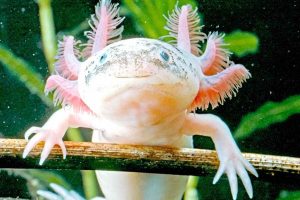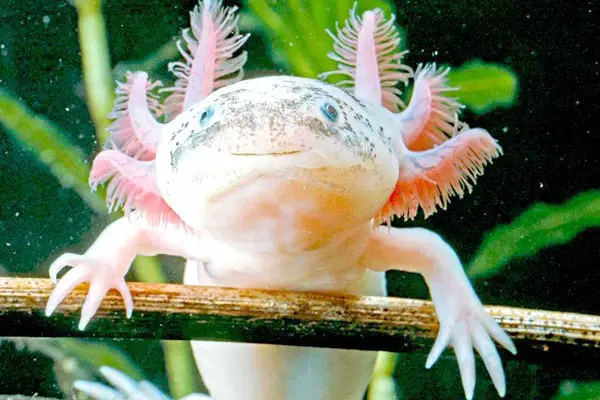Axolotls are carnivorous right from birth. These ancient salamanders are very endangered in their native wild habitat. But thankfully, rising interest among pet keepers is giving the axolotl a fresh start and hope for the future.
One of the keys to successfully keeping a pet axolotl is understanding what these amphibians need to eat. Since this can change throughout your axolotl’s life, it is smart to start learning the right feeding tips from the moment you bring your axolotl home.
In this article, we will review axolotl feeding tips from experienced axolotl keepers and breeders. You will learn how many worms to feed your axolotl based on age, size, and life stage.
Why It Is So Important to Feed Axolotls the Right Amount of Worms?
Axolotls are completely carnivorous. The only vegetable matter an axolotl will ever consume is whatever might be still digesting in the bellies of its protein prey.
Since axolotls are completely dependent on finding enough meat protein to survive, guess what they will eat if competition for food gets intense?
If you guessed “each other,” you now know why it is so important to feed your axolotl enough worms at each feeding.
As well, an axolotl that is still hungry may go after tank mates, including live fish they are kept with.
What Do Very Young Axolotls Eat?
As Reptiles Magazine explains, newborn axolotls are born with a small yolk sac that contains enough nutrition to last a couple of days.
But after the first two days of life, a newborn axolotl will need to take in a lot of protein every day to stay healthy and grow properly. In particular, they need enough nutrition to start growing legs, which will help them hunt.
And on that topic, newborn axolotls are really small! A typical newborn axolotl might only be a half-inch long. So they can’t eat a lot of the larger protein sources they will scarf up when they get older.
Wild newborn axolotls will have a wide variety of food options and will instinctively pursue the ones that they can fit into their tiny mouths. But in a captive setting, it will be up to you to choose the right size food for your axolotl.
A very young pet axolotl – basically from birth to around two inches long – should be fed the following types of foods:
- Brine shrimp (a tiny crustacean)
- Bloodworms (not worms at all – these are the larvae of the midge fly)
- Daphnia (a type of plankton)
- Micro-worms (a type of nematode)
- Chopped-up black worms
How Many Worms Should a Young Axolotl Eat?
Since this particular article focuses primarily on how many worms to feed your axolotl, let’s just look at the worms on the list above.
How many of each type of worm – bloodworms, micro-worms, and black worms – should you feed a young axolotl per feeding?
Bloodworms
Bloodworms come in three types: live, frozen or freeze-dried. These are listed both in order of feeding preferences and nutritional value.
Because bloodworms are so tiny and are not as nutritionally complete as many other worms, the best way to portion them out is by time rather than quantity.
Experienced axolotl keepers will use the “two-minute rule.” This rule states that you should feed as much as your axolotl can consume in two minutes.
But this rule applies only when your axolotl is kept under ideal living conditions with the right temperature. It also applies only once your axolotl has spotted the food and begun to feed.
In other words, don’t start the timer when you put the food in the tank. Start the timer once your axolotl begins to actively feed.
Micro-worms
As their name suggests, micro-worms are incredibly tiny!
The Caudata.org user forum explains that the best way to feed these tiny worms is to dip a cotton swab into the micro-worm habitat and dip up some worms and release them into a cup with plain water along with your axolotl.
You can see how to do this in this short, informative YouTube video by a keeper who is raising axolotl babies.
Blackworms
Blackworms are another favorite choice for young axolotls as they are quite tiny and will continue to wriggle and move for some time after you chop them up.
As Aztec Axolotls explains, juvenile axolotls may be able to eat these worms whole. But you will want to chop them up for safety when feeding newborn axolotls.
What Do Juvenile and Adult Axolotls Eat?
In this section, we will make the jump from feeding hatchling and baby axolotls to feeding your juvenile and adult axolotls.
The primary difference, as you likely already realize, is in the size of your axolotl’s mouth.
Axolotls do not have teeth, per se. But they do have some rudimentary teeth that are primarily used for grasping their prey. They are too blunt and few to be used for chewing.
As Axolotl.org explains, axolotls have five basic life stages. A newborn axolotl will speed through the first four stages in less than two weeks!
Stage five is the longest stage. It can take up to two years for a juvenile axolotl to grow into their full adult size. A full adult size can range from nine to 17 inches, although 10 to 12 inches is typical.
The larger the axolotl grows, the stronger they become, and the more easily they can grasp and swallow larger whole prey.
This means you can start to transition your axolotl from tiny micro-worms, bloodworms, and blackworms to the larger earthworms (nightcrawlers). White worms, Grindal worms, bloodworms (life), and black worms or micro-worms can also be fed as treats.
How Many Worms Should a Juvenile to Adult Axolotl Eat?
Earthworms are an excellent staple worm for a juvenile to adult axolotls.
White worms and Grindal worms should be fed as a treat only because they tend to be high in fat and oil.
Live micro-worms and bloodworms are less nutritious as a staple food source for a growing axolotl. Blackworms can continue to be fed as an alternate staple.
As York shire Worms outlines, a juvenile axolotl can easily be fed one to two medium-size earthworms per day. Once your axolotl is fully grown, you can start to feed one to two larger-size earthworms each day.
shire Worms outlines, a juvenile axolotl can easily be fed one to two medium-size earthworms per day. Once your axolotl is fully grown, you can start to feed one to two larger-size earthworms each day.
What Worms Should You Never Feed Your Axolotl?
There are some worms you should not offer as axolotl food because of safety.
Red wrigglers secrete a slimy fluid called “coelomic fluid” that is toxic to snakes and tastes very bad to axolotls. Your axolotls can get used to this if forced to. But you can expect a lot of regurgitation initially and your axolotl may not want to eat.
Mealworms, super worms, and waxworms all have a chitin exoskeleton. Axolotls can’t digest chitin and the exoskeleton may lodge in their gills and cause choking or suffocation. It is best to avoid all chitinous worms when feeding axolotls.
When you have a firm grasp of what your axolotl should be eating at each life stage and how many worms to offer per feeding, you will feel a lot more confident caring for your axolotl.
Even more importantly, you will be able to figure out when your axolotl isn’t eating enough and look for other reasons, such as water temperature or toxicity, stress, or health issues that could be causing poor appetite.
